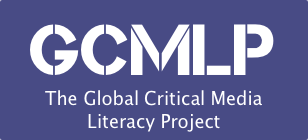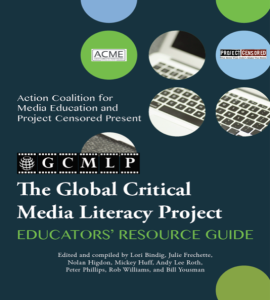_________________________________________________________________________
ABOUT THE GCMLP
In 2015, The Global Critical Media Literacy Project (GCMLP) was created under the Media Freedom Foundation’s non-profit umbrella by Project Censored, the Action Coalition For Media Education, and Sacred Heart University’s Media Literacy and Digital Culture graduate program. The GCMLP provides pedagogy and curricular models for educators working in a variety of disciplines. The GCMLP, which will be housed on participating campuses, empowers and engages students with meaningful learning and an educational pathway from junior college to graduate school and an opportunity for civic engagement in their communities.
The GCMLP and its participants will offer the following:
• critical media literacy classroom activities and assignments provided to educators at no expense, vetted by academic experts
• student- and faculty-generated content edited by academic experts for publication on the GCMLP website and in Project Censored’s annual report on the top news stories that corporate media have ignored, misrepresented, or censored
• a service-learning component to participating faculty’s curricula, in which students collaborate with one another and with faculty to produce works for publication: local investigative journalism, Validated Independent News stories, Internet memes, and solutions-based videos, in addition to analysis of advertising, news abuse, and junk food news
• student clubs, created in collaboration with participating faculty, that sponsor events to share student work and raise awareness about the GCMLP and problems in media
• a steady stream of news and news analysis on the GCMLP website
• an annual GCMLP conference in which students, faculty, and contributors share their work and engage in collaborative action to improve both the GCMLP and critical media education
Why GCMLP? Why Now?
Three major factors drive the work of the GCMLP:
• the state of media education in the United States;
• the vital importance of citizen engagement in our world; and
• a need for equitable pathways to education.
A critical media literacy pedagogy designed around civic engagement has been shown to increase students’ belief that they can make positive change in the world. The GCMLP is designed to provide not only engaging content and action, but an equitable pathway to education founded in networking opportunities and a clear content arc: Students who participate in the GCMLP connect with a network of academics and students in junior college, then transfer to a four-year school that also offers GCMLP, and lastly can apply to Sacred Heart University’s Media Literacy and Digital Culture program, featuring core GCMLP tenets and practices. At each step, students grow their network by connecting with faculty and students at the next level of education; engagement in the GCMLP leads students to completion of transfer, a certificate, and/or a degree (or multiple degrees).
Because the shifts in society brought about by the digital age have altered the skills required for economic and democratic participation, this approach is crucial. Education in the United States does not feature critical media literacy as a core component, so we are too often consumers rather than creators, buyers rather than critics or activists. When students allow media messages—whether from social media, gaming, television, film, music, or streaming cloud-based content—to go unchallenged, powerful elites benefit in terms of increased control of public perceptions, further limitations on what is not or cannot be discussed, and enhanced capacities to set public agendas. Corporate media undermines democracy by thwarting citizens’ desires to be informed about and engaged in the issues that affect them and their communities. Individuals expect colleges and universities to provide them with the skills required to be equitable participants in the 21st-century political economy. However, media literacy in the United States has focused on teaching students the utility of media and digital tools without providing the skills and experiences necessary to be full participants in the 21st-century political economy: the ability to use new technologies to make alternative narratives and to create and navigate media with a critical lens. The GCMLP will provide a core set of critical competences through peer-reviewed, evidence-based curricula and a range of networked opportunities.
COMPONENTS OF THE GCMLP
Critical Media Literacy
Critical media literacy spurs deeper understanding and civic engagement by focusing on digital literacies and competencies for engaging as citizens of the digital world. This pedagogical model is founded on the idea that humanistic objectives should determine the technological choices we make.
The goal for critical media literacy (CML) is to enable citizens to analyze how media industries reproduce sociological structures of power by determining who gets to tell the stories of a society, which points of view and organizational interests shape these stories, and who makes up the target audience. CML courses seek to teach students a critical awareness of power in media, the production of alternative media, and the relationship between media and audiences.
Through institutional analysis, students participating in the GCMLP will
• analyze the unprecedented amount of media content and digital technology that targets them;
• recognize the ways that corporate media seek to colonize their time, money, and intellectual focus; and
• track the differences in how commercial messages solicit them as consumers rather than as citizens.
Service Learning?
Service learning is a pedagogy that emphasizes student participation in course-relevant community service, allowing students to learn while creating meaningful and positive change in their communities. This leads participants to form collaborative relationships with citizens both within and outside the school community, and thus to understand the value of education in context, beyond the classroom walls.
Service learning through the GCMLP, with its focus on critical media literacy, will teach students to navigate the vast media world and, just as importantly, to create spaces within which to disseminate their work to the communities they serve and to broader publics. In our individualistic world, educators must be encouraged to teach students the value of collaboration as a method for creating meaningful change, and the media world is ripe for such reform.
Students who participate in service-learning programs—including those who are typically underrepresented in college—are more likely to be integrated in their communities, to feel validated, and to persist in their college careers. Through its focus on service learning, the GCMLP lives its prosocial, equity-based mission in practice as well as in curriculum.
Opportunities for Students and Educators
Students can
• publish local investigative journalism;
• generate advertising analyses;
• publish academic works in the annual Project Censored book and on the GCMLP website;
• develop new software;
• present at national conferences;
• nominate and research Validated Independent News stories;
• learn how to use social media for publishing purposes and activism;
• earn a certificate and degrees in critical media literacy and related fields; and
• work with faculty from a variety of institutions to research and write articles for publication.
Educators can
• publish original works in the Project Censored book, on the GCMLP website, and in the ACME electronic journal;
• present at conferences;
• become a GCMLP officer;
• create programs and courses in critical media literacy and related fields;
• engage in staff development; and
• receive lecture notes, lecture slides, and classroom activities across the disciplines.


